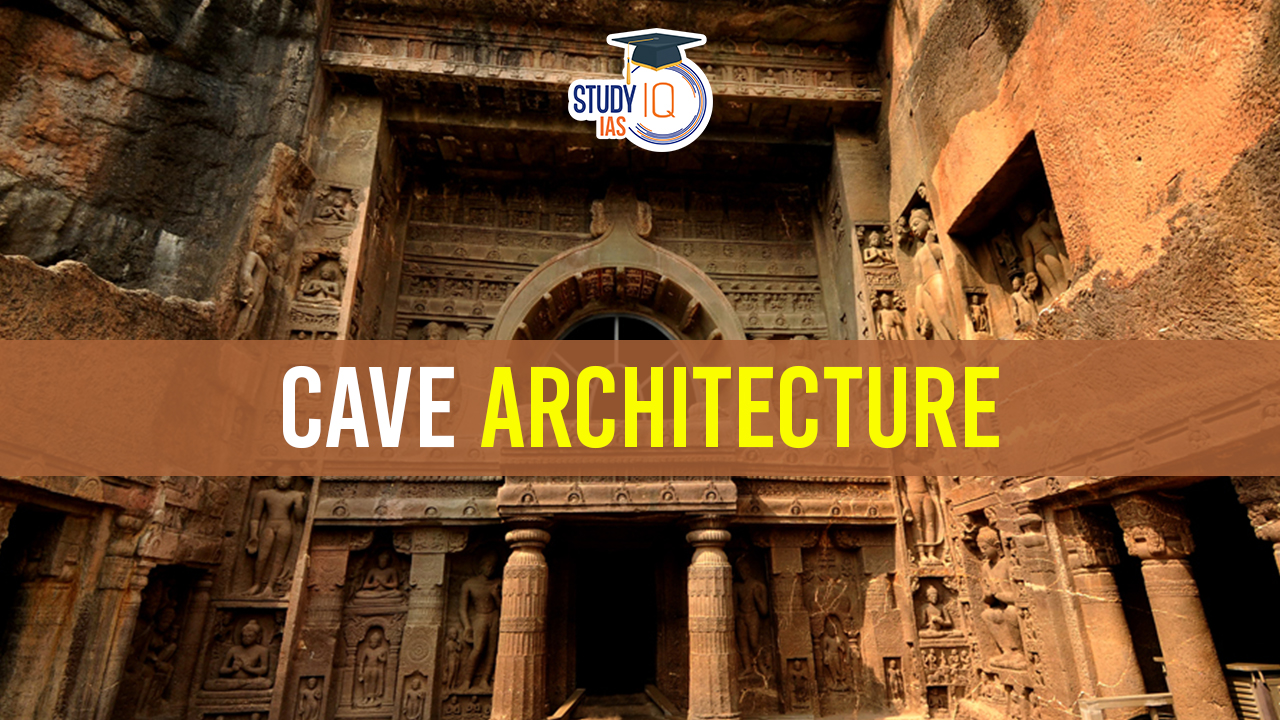Table of Contents
India boasts a rich heritage of cave architecture, exemplified by sites such as Ajanta and Ellora Caves in Maharashtra, showcasing intricate Buddhist rock-cut temples. Elephanta Caves in Mumbai feature Hindu sculptures, including the impressive Trimurti. Badami Cave Temples in Karnataka display a fusion of Dravidian and Nagara styles. Udayagiri and Khandagiri Caves in Odisha served as residential quarters for Jain monks. Bhimbetka Caves in Madhya Pradesh unveil prehistoric rock paintings, while Pandavleni Caves in Nashik house Buddhist viharas, all reflecting India’s diverse cultural and religious history.
We’re now on WhatsApp. Click to Join
What is Cave Architecture?
Cave architecture in India refers to the construction and modification of natural caves for various purposes, reflecting the country’s rich cultural and religious history. Notable examples include the Ajanta and Ellora Caves in Maharashtra, which house intricate Buddhist, Hindu, and Jain rock-cut temples dating back to ancient times. These caves often feature detailed sculptures, paintings, and architectural elements, showcasing the artistic and religious diversity of India. Other instances include the Elephanta Caves near Mumbai and the Badami Cave Temples in Karnataka, each representing distinct periods and religious traditions in Indian cave architecture.
History of Cave Architecture
- Historical Reverence: Caves in India have been revered since ancient times, serving as places of worship and shelters. Primitive caves were naturally used by locals for various purposes.
- Mesolithic Period Modification: Data indicates that caves in India were employed and modified as early as the Mesolithic period (6000 BC), with rock-cut designs emerging as examples of early architectural craftsmanship.
- Buddhist Influence: With the arrival of Buddhist missionaries, natural caves were utilized as Varshavasa (rainy season dwelling) and temples, facilitating a monastic lifestyle aligned with Buddhist aesthetics.
- Evolution of Rock-Cut Structures: Caves carved out of colossal rocks gained popularity due to their durability compared to other materials like wood. Over time, these structures evolved to become more architecturally enhanced.
- Western Deccan Region Significance: The western Deccan region witnessed early cave excavations, particularly Buddhist shrines and monasteries dating between 100 BC and 170 AD.
- Jain Influence: Many Jain cave basadi, shrines, and temples represent early examples of rock-cut architecture in the region.
- Barabar Caves in Bihar: The Barabar Caves in Bihar are the oldest surviving caves in India, showcasing rock-cut architecture. They feature Hindu and Buddhist sculptures dating back to the 3rd century BC during the Maurya Empire.
- Maharashtra’s Contribution: Maharashtra houses some of the earliest cave temples, including the 2nd century BC Bhaja Caves, the 1st century BC Bedse Caves, the Karla Caves dating from 2nd century BC to 5th century AD, the Kanheri Caves developed between the 1st century BCE and 10th century CE, and the Ajanta Caves dating from 2nd century BCE to around 480 or 650 CE.
Types of Caves
Caves in India stand as architectural marvels and are closely associated with Buddhism, Hinduism, and Jainism. The topography of the Western Ghats, characterized by deep ravines and rocky exposures, naturally drew religious adherents seeking shelter and sacred spaces.
Buddhist Caves
- Ancient Buddhist Legacy: The majority of surviving cave temples, approximately 1200, belong to Buddhism. Notable examples include the earliest Kanheri Caves in Maharashtra, occupied by Buddhist monks from 200 BCE to 650 AD.
- Trade and Commerce Influence: Buddhist caves are strategically located along major trade routes, reflecting the ideological connection between Buddhism and trade. Wealthy traders commissioned the enhancement of cave interiors, incorporating sectionalized viharas and chaityas adorned with intricate carvings, reliefs, and paintings.
- Viharas and Chaityas: Viharas served as residential areas for monks, while chaityas were cave shrines for congregational worship, featuring pillared circular chambers for circumambulating around the stupa.
- Architectural Evolution: The 5th century AD marked a second phase in Buddhist architecture, introducing statues of Lord Buddha, Jataka stories, and deities associated with Buddhism. Elaborate sculptures were incorporated into viharas.
Hindu Caves
- Continuity with Alterations: Hindu caves, an extension of Buddhist architecture, exhibit alterations to suit Hindu customs. Excavated between the 4th and 8th centuries AD, these caves depict themes from Hindu epics like the Ramayana and Mahabharata.
- Distinctive Features: Hindu cave architecture is characterized by mandapas, rock-hewn columned halls for deities, and rathas, shrines chiseled from monolithic rocks. Prominent during the Dravidian period, these features add a unique touch to Hindu cave complexes.
Jain Caves
- Culmination of Cave Architecture: Jain cave architecture, considered to span from the 6th to the 12th century AD, marks the end of the cave construction era.
- Embellished Sculptures: Jain caves, scattered across the Indian subcontinent, showcase highly adorned sculptures illustrating the tales of Tirthankaras in the Jain Pantheon.
- Artistic Richness: Some Jain caves, like those in Ellora (Maharashtra) and Sittanavasal (Tamil Nadu), feature elaborately painted ceilings, adding to the artistic richness of Jain cave architecture.
India’s caves embody a fascinating tapestry of religious diversity, with each tradition leaving its unique imprint on the country’s architectural landscape. From the serene Buddhist viharas to the intricate Hindu mandapas and the richly adorned Jain caves, these structures stand as testaments to the spiritual and artistic journey of India’s ancient civilizations.
Major Caves in India
Cave architecture in India has a profound historical significance, dating back to ancient times. Primarily, Buddhist and Jain monks utilized these caves for worship and residence, with the Mauryans recognized as pioneers in rock-cut cave architecture.
Ajanta Caves
Situated near Aurangabad, Maharashtra, the Ajanta Caves are rock-cut masterpieces nestled between the Sahyadri ranges along the Waghora River.
- Discovery: Accidentally stumbled upon by a British Officer while tiger hunting in 1819 AD.
- Composition: The Ajanta Cave complex consists of 29 caves, including 25 Viharas (residence caves) and 4 Chaityas (prayer halls).
- Periods of Construction: Constructed during the Hinayana period of Buddhism, with additional caves added during the Mahayana period.
- Architectural Features: Chaityas served as prayer sites with pillared halls and stupas at the center.
- Timeline: Constructed between 200 BC and 658 AD, under the patronage of the Vakataka kings.
- Fresco Paintings: The caves showcase vibrant fresco paintings depicting Buddhism themes, Buddha’s life, and Jataka stories. Notably, the paintings lack the color blue.
- Historical Accounts: Mentioned in the travel journals of Chinese Buddhist Pilgrims Fa Hien and Hieun Tsang.
- Recognition: Designated as a UNESCO World Heritage Site.
Ellora Caves
Located in Maharashtra, the Ellora Caves, also known as Verul Leni, were carved out starting from the 5th century.
- Rock-Cut Architecture: Comprising 34 caves, including 17 for Brahmanical faith, 12 Buddhist, and 5 Jain caves.
- Kailash Temple: Famous for the Kailash Temple, the largest monolithic excavation globally, dedicated to Lord Shiva.
- Jain Temples: Indrasabha and Jagnnathsabha represent Jainism within Ellora.
- Religious Diversity: Unlike Ajanta, Ellora features caves representing Hinduism, Buddhism, and Jainism.
- Architectural Complexity: Presence of double and triple-storey caves, as well as courtyards carved on the sloping sides of the hill.
- UNESCO Recognition: Inscribed as a UNESCO World Heritage site.
Elephanta Caves
Dating back to the 8th century, the Elephanta Caves were initially a Buddhist site later dominated by the Shaivite faith.
- Basalt Rock Carvings: Carved out from solid basalt rock on Elephanta Island.
- Religious Transition: Originally Buddhist, later dominated by Shaivism.
- Sculptural Highlights: Notable sculptures include the Trimurti figure of Shiva, Ravana shaking the Kailash, the Tandav dance of Shiva, and Ardhanarishvara.
- UNESCO Heritage: Designated as a UNESCO World Heritage site in 1987.
Barabar Caves
The Barabar Caves form a cluster of four caves located around 40 km from Bodhgaya in Bihar.
- Cave Diversity: Comprising Lomash Rishi cave, Sudama caves, Vishwakarma caves, and Karan Chaupar Caves.
- Ajivika Sect: Built for the Ajivika sect, reflecting connections to Buddhism, Hinduism, and Jainism.
- Lomas Rishi Cave: Represents India’s earliest example of rock-cut architecture, carved from solid granite rock.
Bagh Caves
Dating back to the 6th century AD, the Bagh Caves are located on the banks of the Bagh River in Madhya Pradesh.
- Earthly Depictions: Executed in tempera, these caves exhibit more earthly and human themes compared to Ajanta.
- Materialistic Paintings: The paintings are more materialistic than spiritualistic in nature.
- Condition: Unfortunately, the current condition restricts appreciation to on-site visits.
Junagadh Caves
Situated in the Junagadh region of Gujarat, these Buddhist caves feature a 30-50 ft high fortress called the upper court.
- Buddhist Heritage: These caves are a testament to Buddhist heritage in Gujarat.
- Fortress Presence: The caves include a significant fortress called the upper court in front of the prayer hall.
Nashik Caves
Dating back to the first century AD, the Nashik Caves consist of a series of 24 Buddhist caves, also known as Pandav Leni.
- Hinayana Period: Constructed during the Hinayana period, later influenced by Maharana in the subsequent period.
- Water Management: Notable water management system with a water tank covered with solid rock.
Mandapeshwar Caves
Located in Borivali near Mumbai, the Mandapeshwar cave, initially a Brahmanical cave, transformed into a Christian cave.
- Gupta Period: Built during the late Gupta period.
- Religious Transformation: Initially a Brahmanical cave, later converted into a Christian cave.
- Sculptural Depictions: Sculptures of Nataraja and Ardhanariswari can be observed in the cave ruins.
Karle Caves
Built around the beginning of the Christian era, the Karle Caves feature spectacular rock-cut architecture.
- Similar to Bhaja Caves: The cave pattern is reminiscent of the Bhaja Caves, but larger and more spectacular.
- Chaitya Karle Cave: Dug deep into the rock, it is India’s largest rock-cut chaitya.
Kanheri Caves
Near Mumbai, the Kanheri Caves follow the design of the Karle Caves, with 109 caverns cut out of Basalt Rock.
- Cave Diversity: Comprising 109 caverns, with a majority being Viharas and some notable Chatiyas.
- Maharana Influence: Displays influence from the Maharana set, evident in the outside walls depicting Buddha’s images.
Udayagiri Caves
Located in the Vidisha district of Madhya Pradesh, the Udayagiri Caves were built under the patronage of Chandragupta II in the early 5th century AD.
Significance of Cave Architecture
The caves from ancient and medieval eras offer a captivating glimpse into diverse architectural styles across various periods and religions. Through relics, motifs, murals, and sculptures, these caves provide profound insights into the traditions, customs, and lifestyles of ancient inhabitants. Moreover, they serve as a testament to the remarkable achievements in structural engineering and artistic expressions of their respective times. As a result, these caves draw innumerable tourists and architectural enthusiasts throughout the year, showcasing the enduring appeal of their historical and cultural significance.
Cave Architecture UPSC
India’s cave architecture, seen prominently in sites like Ajanta and Ellora Caves, reflects a rich cultural and religious history. From Buddhist viharas to Hindu mandapas and Jain caves, these structures showcase diverse traditions. Caves were revered since ancient times, evolving from natural shelters to intricately carved temples. Buddhist caves, like Kanheri, were strategically placed along trade routes. Hindu caves, a continuation of Buddhist architecture, display alterations to suit Hindu customs. Jain caves, marked by elaborate sculptures, signify the culmination of cave construction. This architectural tapestry, with its historical reverence and artistic richness, remains a significant aspect of India’s heritage.


 Kailash Mansarovar Yatra to Resume Soon,...
Kailash Mansarovar Yatra to Resume Soon,...
 Bihu Festival and Dance of Assam, Histor...
Bihu Festival and Dance of Assam, Histor...
 Jallianwala Bagh Massacre, Date, History...
Jallianwala Bagh Massacre, Date, History...





















